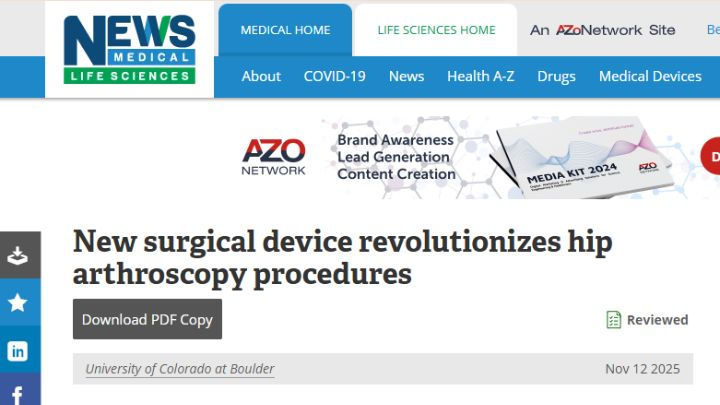Surgical Advancements Revolutionize Hip Arthroscopy: Introducing the CAP-LIFT Cannula
- Nov 13
- 3 min read

Innovations in orthopedic technology are rapidly transforming how surgeons diagnose and treat joint injuries, making reconstruction, restoration, and repair procedures more effective and reproducible. These Surgical Advancements are not only improving surgical efficiency and outcomes but are also accelerating patient recovery times.
A cornerstone of this technological leap is visualization. The introduction of ultra-high-definition imaging, sometimes coupled with interactive imaging software, provides surgeons with sharper visualization and greater precision inside the joint than ever before. Dr. John Christoforetti notes that this level of clear visualization and detailed definition aids in the precise interpretation and treatment of sports injuries. Ultra-high-def imaging allows for detailed analysis of articular cartilage quality and guides the interpretation of fatty infiltration within the hip labrum, thereby increasing the accuracy in identifying injuries. Dr. James B. Chen adds that high-def cameras simplify complex arthroscopies, enabling more accurate assessment of cartilage integrity and better visualization of structures like the posterior meniscus, which are often difficult to access.
Beyond visualization, the operating room environment is becoming drastically more efficient. Innovations such as wireless arthroscopy towers and cameras are entering surgical procedures, with the goal of eliminating cords and pump tubing that traditionally clutter the space and reduce maneuverability. Dr. Derek Ochiai champions Bluetooth-enabled video cameras but anticipates the future goal of a totally cordless system to further increase efficiencies. Furthermore, "smart" automated pumps are revolutionizing fluid management by automatically regulating flow and maintaining consistent intra-articular pressure. This consistency prevents pressure variations that might lead to visual impairment from bleeding, ensuring greater visibility throughout the procedure.
While these general improvements enhance overall efficiency, specific tools are redefining procedures like Hip Arthroscopy, a Minimally Invasive Surgery. This procedure has seen a 600% increase in utilization over the past 15 years. The latest breakthrough in this area is the innovative CAP-LIFT Cannula.
Developed through a collaboration between research professor Jacob Segil and Dr. Omer Mei Dan, this redesigned surgical instrument is transforming arthroscopic procedures in the hip region, making them safer and more efficient. Cannulas are thin tubes, analogous to a straw, that allow surgeons to insert tools and cameras into the joint. Traditionally, these circumferential tubes restrict a surgeon’s range of motion, creating difficulty in manipulating tissue inside the joint—a constraint Segil compared to trying to manipulate tissue using a chopstick inside a straw.
The CAP-LIFT Cannula addresses this by being "slotted," meaning it comprises only about 120 degrees of material instead of a full circumference, which grants the surgeon a wider range of motion. Crucially, the CAP-LIFT also integrates a specialized anchoring system. Conventional techniques require a second surgical assistant to hold a stainless steel tool called a "sled" to guide instruments and maintain joint access. This dynamic is often time-consuming, difficult, and potentially hazardous, as the removal or re-entry of the sled increases the risk of damaging surrounding tissue, muscle, or tendons. By combining the cannula and the sled into a single, fixed device—like a straw anchored at two ends—the CAP-LIFT grants easy and stable access to the joint without needing extra hands.
The technology, which was acquired by Smith and Nephew in 2022 and recently launched in October, has already been used in over 100 successful surgeries, generating "fantastic" nationwide feedback. This focus on restoring normal anatomy and enhancing precision reflects the future of orthopedics, which expects further integration of AI, augmented reality, and 3D visualization systems. The CAP-LIFT Cannula stands as a prime example of how collaboration between engineering and medicine is leading to meaningful, patient-focused change.
🔖 Sources
Keywords: Hip Arthroscopy
Hip Arthroscopy











Comments